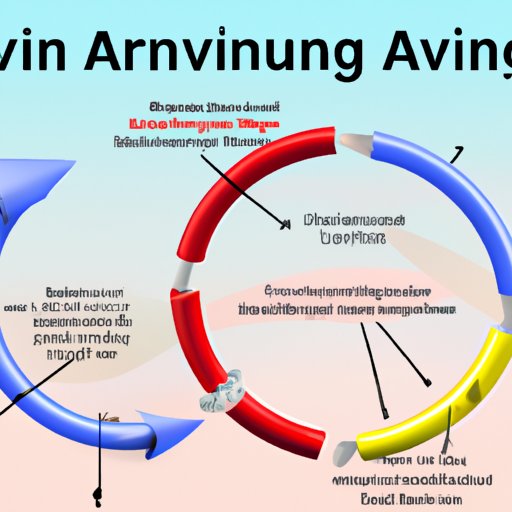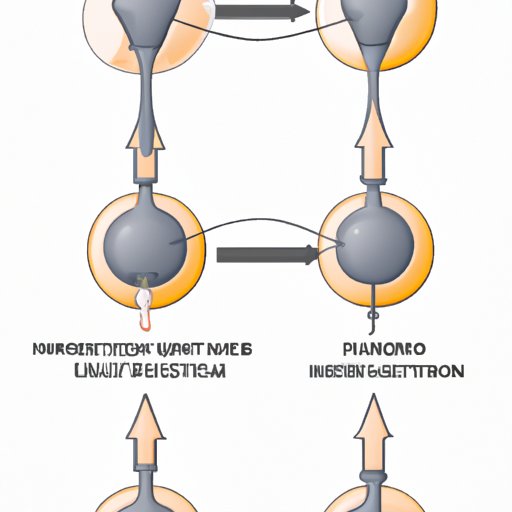Introduction
Nuvaring is a popular form of birth control that has been used by millions of women around the world. It is a small, flexible ring that is inserted into the vagina to prevent pregnancy. The ring contains hormones that are released over a three-week period and prevents ovulation, thus preventing pregnancy. But how does Nuvaring work? This article will explore the science behind the mechanism of Nuvaring and provide a comprehensive guide to understanding its working process.
Exploring the Science Behind Nuvaring: How Does it Work?
Nuvaring works by releasing two hormones, ethinyl estradiol (EE) and etonogestrel (ENG). EE is a type of synthetic estrogen, while ENG is a type of synthetic progestin. These hormones work together to prevent pregnancy by inhibiting ovulation, thickening cervical mucus, and thinning the lining of the uterus.
The insertion and removal process of Nuvaring is relatively simple. To insert the ring, you need to wash your hands, squeeze the sides of the ring together, insert the ring into the vagina, and push the ring up as far as possible. To remove the ring, you need to wash your hands, insert your finger into your vagina, hook your finger under the rim of the ring, and gently pull the ring out.
Nuvaring uses a unique delivery system to deliver hormones into the body. The ring is made from a special type of plastic that slowly releases the hormones into the bloodstream over a three-week period. Once the hormones are released, they travel through the bloodstream and are absorbed by the body.

A Comprehensive Guide to Understanding the Mechanism of Nuvaring
Once the Nuvaring is inserted, it starts releasing the hormones into the body. The EE and ENG hormones work together to inhibit ovulation, thicken cervical mucus, and thin the lining of the uterus. This prevents sperm from reaching an egg and fertilizing it, thus preventing pregnancy. The hormones are also responsible for regulating the menstrual cycle, making it more regular and predictable.
The ring needs to be replaced every three weeks. After 21 days, the hormones in the ring start to decrease, and after 28 days, the ring is no longer effective. The ring should then be removed, and a new one should be inserted seven days later. If the ring is not replaced within seven days, backup contraception should be used.
Nuvaring can cause some side effects, such as nausea, headaches, breast tenderness, and weight gain. It can also increase the risk of developing blood clots and other serious medical conditions. Women who have a history of heart disease, stroke, or other cardiovascular diseases should talk to their doctor before using Nuvaring.
All You Need to Know About Nuvaring and Its Working Process
Nuvaring is highly effective at preventing pregnancy when used correctly. According to a study by The American College of Obstetricians and Gynecologists, Nuvaring is 99% effective in preventing pregnancy. This means that if 100 women use Nuvaring correctly, only one of them will become pregnant in a year.
Nuvaring also has several benefits. It is convenient, easy to use, and discreet. It does not interfere with sex, and it does not require daily attention. Furthermore, it can help regulate the menstrual cycle and reduce the symptoms of premenstrual syndrome (PMS).
Nuvaring may not be suitable for everyone. Women who smoke, have certain medical conditions, or are over 35 years old should talk to their doctor before using Nuvaring. Other alternatives to Nuvaring include oral contraceptives, intrauterine devices (IUDs), and barrier methods like condoms.
What Is Nuvaring and How Does It Function?
Nuvaring is available in two types: the traditional Nuvaring and the Nuvaring Plus. The traditional Nuvaring contains both EE and ENG, while the Nuvaring Plus contains EE, ENG, and a third hormone called drospirenone. Both types of Nuvaring are inserted into the vagina, where they slowly release hormones into the bloodstream.
In order to use Nuvaring correctly, it is important to follow the instructions provided by your doctor. The ring should be inserted into the vagina on the first day of your period, and it should be left in for 21 days. After 21 days, the ring should be removed and a new one should be inserted seven days later.
When using Nuvaring, it is important to take certain precautions. The ring should never be flushed down the toilet, and it should always be stored in a cool, dry place. Additionally, the ring should be checked periodically to make sure it is still in place.
Unveiling the Mystery of Nuvaring: How Does It Work?
Nuvaring is an effective method of birth control that is safe and convenient to use. It works by releasing hormones that prevent ovulation, thicken cervical mucus, and thin the lining of the uterus. This prevents sperm from reaching an egg and fertilizing it, thus preventing pregnancy. Nuvaring is 99% effective when used correctly and can help regulate the menstrual cycle and reduce the symptoms of PMS.
Although Nuvaring is generally safe and effective, there are some potential risks and side effects associated with its use. Women who have a history of heart disease, stroke, or other cardiovascular diseases should talk to their doctor before using Nuvaring. Additionally, Nuvaring may not be suitable for women who are over 35 years old, smoke, or have certain medical conditions.
Other alternatives to Nuvaring include oral contraceptives, IUDs, and barrier methods like condoms. Each method has its own set of advantages and disadvantages, so it is important to discuss all of your options with your doctor before making a decision.
Conclusion
Nuvaring is a popular and effective form of birth control that has been used by millions of women around the world. It works by releasing hormones that prevent pregnancy by inhibiting ovulation, thickening cervical mucus, and thinning the lining of the uterus. Nuvaring is 99% effective when used correctly and has several benefits, including convenience, ease of use, and discreetness. However, it is important to be aware of the potential risks and side effects associated with its use.
In conclusion, Nuvaring is a safe and effective method of birth control, but it is important to understand how it works and be aware of the potential risks and side effects associated with its use. Talk to your doctor to determine if Nuvaring is right for you and explore all of your options before making a decision.
(Note: Is this article not meeting your expectations? Do you have knowledge or insights to share? Unlock new opportunities and expand your reach by joining our authors team. Click Registration to join us and share your expertise with our readers.)
